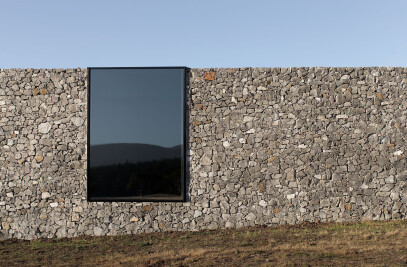The house has a duality of character and experience defined by context. On approach its angular and severe form is a toughened abstract container, bracing itself against the robust Tasmanian landscape and weather. On passing through the “hollowed out” portals the warm and sheltering underbelly is exposed and acts as a protective envelope. These areas of inbetween, outside but surrounded by the building’s form are a result of a considered approach to outdoor living within typical Tasmanian weather condition, ie “4 seasons in one day”. They allow one to sit in the sunshine but avoid the cold winter wind, or alternatively sit outdoors but avoid the harsh high UV summer sun. The spaces shift from fully enclosed to semi enclosed, with roof and without, culminating in a roof deck for maximum exposure and view.
The client wish for the kitchen to be the heart of the home generated the internallayout. A defined grid relating to the various uses set the kitchen at its centre, becoming slightly deformed as rooms were angled towards particular views. Revolving around this heart the house eventually lifts to peer over the first level ring and towards Mt Wellington. Voids make the heart visible from other spaces within the house. The compact plan is made to feel larger via the positioning of the voids and linkedexternal areas. Internal and external spaces are blurred at one extreme, and highly contained in others. Dark metallic cladding was employed for low maintenance and to allow the building to recede into the shadows of the hill-scape when viewed from afar. Entry points and areas for outdoor living were cleaved out of the metallic box and lined with “warm” timber. The house has a suspended concrete slab through the living area for thermal mass, absorbing the heat transferred through glass walls to the north. Natural ventilation operates via airflow through the connecting adjacent tree voids.

































